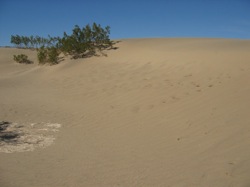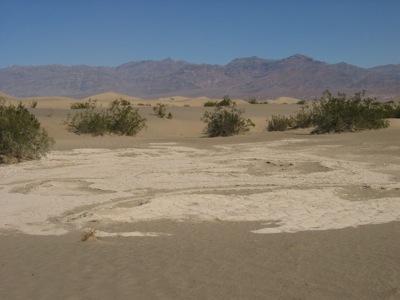This week conservationists issued their annual list of the “most endangered” national parks, including two in California (Joshua Tree and Yosemite). There are many ways to measure the health of a park; the air, the water. This week on Quest radio, I examine an often overlooked vital sign: the sound. Thanks to Climate Watch contributor Sasha Khokha, Bob Roney, Bernie Krause and the staff at NPS Ft. Collins for many of the sounds you hear in that segment, nicely mixed by Ceil Muller.

The quietest place I’ve ever been was in a national park and I don’t think I’ll ever forget what it was like.
Okay, “quiet” is a somewhat subjective thing. When I lived on the upper (way upper) west side of Manhattan in the 1980s, any interval without hearing a car alarm seemed like blessed relief. Quiet can be measured, of course, with sound pressure meters. Anything below about 40 decibels is pretty darn quiet for most people’s purposes (a state that I doubt was ever attained in my apartment on West 119th St.).
The National Park Service (NPS) says the quietest place it has yet measured is a spot in Great Sand Dunes National Park, where Vicki McCusker, who helps oversee the natural sounds program for the Park Service, says it was “bottoming out” their meters.
I’ve never been there but it’s hard to imagine greater quietude than an afternoon I spent in Death Valley. Coincidentally this was also on a sand dune, near Stovepipe Wells. It was also Christmas Day, which kept the tourist traffic to a minimum. It was at a point in my life when I was in desperate need of some deep introspection, so I parked my car along Highway 190 and trekked into the dunes, found an accommodating slope and sat down. Occasionally a fly (or something) would buzz by. Other than that, the loudest thing was the buzzing in my own head, which I can only hope would’ve been inaudible to anyone with me.

It’s interesting how, when things get really quiet, our bodies try to make up for it with ringing ears and internal chaos. The noted bioacoustician Bernie Krause talks about the time he and his wife, Kat were hosting guests from New York, who literally had to leave the Krause’s semi-secluded Glen Ellen “sanctuary” because the night-time quiet was creeping them out.
I asked Krause what he could draw from that. “Well, it tells me that we’re more insane than I ever thought in the first place,” he mused. “I mean, we’re definitely verging on pathological. Because it’s exactly those kinds of sounds–the urban acoustic envelope in which we enfold ourselves–that kind of urban noise that’s driving up the numbers of prescriptions for Prozac.”
Surveys of national park visitors would seem to bear that out. In the early 1990s, NPS surveyed 15,000 visitors in 39 parks, about noise issues (NPS manages 391 “units” nationwide, 58 of which are designated as “parks”). More than nine out of ten visitors surveyed cited “enjoyment of natural quiet” as a reason for visiting. This survey provided some juice for the ongoing natural sounds program in the parks.
An open question is: where does it go from here? Much of the current effort in the parks appears to be geared toward developing “air tour management plans,” a response to concerns that first arose over the increasingly crowded skies above the Grand Canyon. McCusker told me that while aircraft overflights are the most pervasive noise issue across the parks, the most common complaint is probably over loud motorcycles (note to “straight-pipe” Harley owners).
Krause, who conducted a year-long project documenting soundscapes in Sequoia-Kings Canyon National Park, hopes the research will also be used to develop new rules governing on-the-ground noise pollution. “If the parks can set aside places where people can go and hear the natural world as it is, at any season of the year, then that will be a really big benefit for visitors coming to the parks,” he says. “Otherwise, you’re seeing the parks with the wrong soundtrack. It’s like watching Star Wars without a soundtrack.”
Leave a comment with your own “quietest place.”
In 2003, Bernie Krause & I co-produced a short film for the National Park Service, which takes you on a 4-and-a-half-minute journey from the “urban sound envelope” to a restful spot in Sequoia National park.
Tune in to PBS this week for the premiere of Ken Burns’ new series: The National Parks: America’s Best Idea. Also Quest television explores the Golden Gate National Recreation Area, an urban national park. This program is now available for viewing at the Quest site (see previous link).
One thought on “A Climate of Quietude”
Comments are closed.

August 3, 2008 2:00 AM EST. Calamity Lean-to near the Upper Works, Adirondack Park,Great State of New York.
The quietest place I’ve ever been. No birds, no buzzing of insects; so quiet I could hear white noise. Wonderful place.